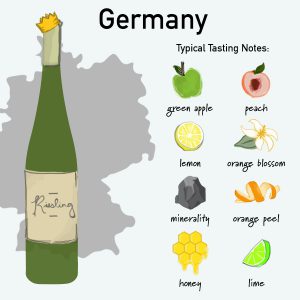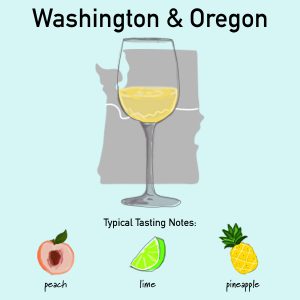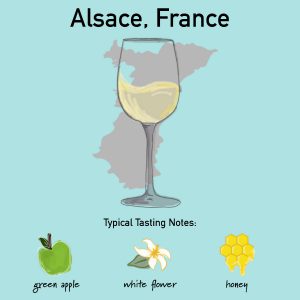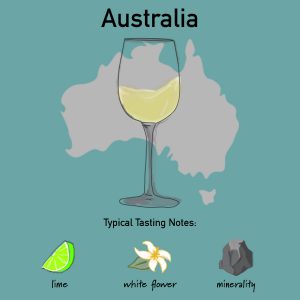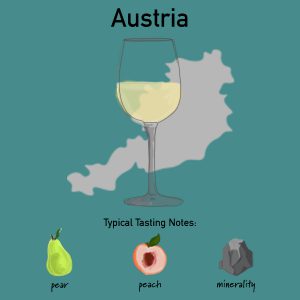One of Riesling’s most unique and celebrated qualities is its vibrant expression of terroir, commonly defined as “a sense of place.” In other words, certain elements of the soil and microclimate that the grapes are grown in are noticeable factors in the wine’s taste profile. This transparency of terroir means that Riesling grown in different regions will produce wines with markedly distinct characteristics.
With over 23,000 hectares planted to Riesling in Germany alone, fully exploring the country’s array of Rieslings is no small feat. Beyond Riesling’s birthplace along Germany’s Rhine River, Riesling is also grown around the world from Australia to Oregon.
How does the flavor profile of Riesling differ across countries and continents?
German Riesling
Total Riesling surface area in Germany (2015): 23,596 hectares
Total vineyard acreage in Germany (2018): ~103,000 hectares
Riesling’s homeland of Germany checks all the boxes of an ideal Riesling region. As such, Riesling is grown in all 13 of the country’s wine regions, and it’s the world’s largest producer of Riesling.
Among the most northerly winegrowing areas in the world, Germany is considered a “cool climate” region. Compared to most winemaking countries, Germany’s vineyards receive less sunshine during the growing season and see lower average temperatures. The bulk of rainfall occurs in the summer and declines during the final stages of ripening, opposite of typical precipitation patterns in much of southern Europe.
Slow to mature, Riesling is predestined for regions where it can finish ripening completely under the autumn sun, benefitting from nutrients in the soil and developing its characteristic minerality and well-balanced acidity.
Riesling is able to thrive in a wide range of soils, but heat-retaining, stony soils on steep, south-facing sites along river valleys provide optimal conditions, such as those found along the rolling hills and valleys of the Rhine River and its tributaries.
A “typical” German Riesling is pale greenish yellow to light golden yellow in color, light to medium-bodied and has a pronounced acidity and relatively low ABV. Common aromas and flavors include green apple, peach, and lime.
On the Mosel’s cool-climate steep sloped vineyards, Riesling is typically delicate and intensely mineral, partially from the slate soil it’s grown on. Young wines might smell of flint stone, and mature growths can show interesting petrol notes. While gasoline and wine may sound like an odd match, wine aficionados celebrate and seek out this quality in German Riesling!
Germany’s Rheingau region is known for more fuller-bodied Riesling with structured acidity, while Rheinhessen directly south yields Riesling with more mild acidity, medium body, and stone fruit flavors. Further south in the warm, dry Pfalz, you’ll find refreshing fuller-bodied Riesling with flavors of orchard fruit and earthy and spicy elements.
With age, German Riesling can evolve to express honeycomb, beeswax, earthy spices, and candied fruit.
After Germany, a few other regions around the world maintain prominent plantings of Riesling and are regarded as key Riesling regions…
Washington/Oregon (USA) Riesling
Total Riesling surface area in the USA (2015): 4,605 hectares
Total vineyard acreage in the USA (2018): ~439,000 hectares
Key regions: Columbia Valley, Willamette Valley, Yakima Valley
German immigrants brought Riesling vines to the Americas in the late 19th century, and Washington State is the largest Riesling producer in the U.S.
Washington and Oregon Rieslings are produced in both dry and sweet styles. A typical Pacific Northwest Riesling is off-dry, easy-drinking, and floral with tropical fruit flavors and higher acidity than other wines from these regions. In the region’s most prominent Riesling-producing AVA, the Columbia Valley, cool evenings offset high summer temperatures to retain the crisp acidity.
Note: Riesling is also produced elsewhere in the U.S., such as the cooler parts of California, New York’s Finger Lakes, and Michigan.
Alsatian Riesling
Total Riesling surface area in France (2015): 4,025 hectares
Total vineyard acreage in France (2018): ~793,000 hectares
The French region of Alsace is located just across Germany’s southwest border. It grows many of the same grapes as wine regions in Germany, just across the Rhine River. As such, the Riesling of this region shares many similarities with German Riesling – aromatic and expressive with high acidity and steely minerality.
That said, the climate is warmer and drier, and aromas of Alsatian Riesling are more floral. They also tend to be higher in alcohol content and are sometimes described as creamier in texture. The wines are typically dry or off-dry and racy with fuller body, but they are also produced in sweeter styles as well.
Australian Riesling
Total Riesling surface area in Australia (2015): 3,157 hectares
Total vineyard acreage in Australia (2018): ~146,000 hectares
Key regions: Eden Valley and Clare Valley
Riesling is closely linked to Australia’s viticultural history, when vines were brought over from the Rheingau in the 1800s. Australian Rieslings are especially know for lime and lemon flavors, as well as white flower, orange blossom, and tropical fruit.
Though Australia is warmer and drier than many regions known for Riesling, temperatures drop at night in higher altitudes, preserving Riesling’s iconic acidity. With fuller body and higher alcohol content, the texture of Australian Riesling is sometimes described as oily.
In addition to South Australia, Riesling-producing regions can also be found in Western Australia, Victoria, and Tasmania.
Austrian Riesling
Total Riesling surface area in Austria (2015): 2,068 hectares
Total vineyard acreage in Austria (2018): ~46,500 hectares
Key regions: Wachau, Kremstal, Kamptal
In addition to a common language, Austria and Germany share a number of the same grape varieties. In Austria, Riesling is the most important grape after Grüner Veltliner in the regions along the Danube River and its tributaries.
Austrian Riesling is known to be dry and clean with relatively higher alcohol content, a fuller body, and a long finish, and more tropical and intense than German Riesling. Like many areas in Germany, the best sites in the Wachau, Austria’s most renowned winemaking region, are the steep, terraced, south-facing slopes of the river valley. Riesling also flourishes on similarly steep terraces and riverbanks in Kamptal and Kremstal.
Cheers to Riesling all around the world! Explore Germany’s other wine varieties, both white and red, and dig deeper into the country’s unique terroir.
